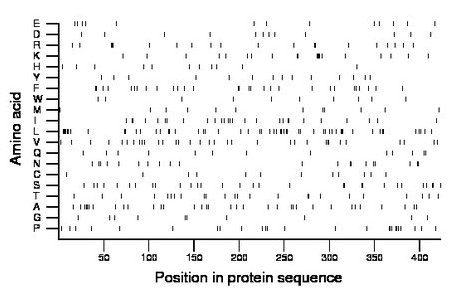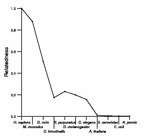
| Name: GPR83 | Sequence: fasta or formatted (423aa) | NCBI GI: 223633971 | |
|
Description: G protein-coupled receptor 83
|
Referenced in: G-Protein-coupled Receptors
| ||
|
Composition:

Amino acid Percentage Count Longest homopolymer A alanine 8.0 34 2 C cysteine 2.8 12 1 D aspartate 2.8 12 1 E glutamate 3.1 13 1 F phenylalanine 6.9 29 2 G glycine 2.4 10 1 H histidine 2.6 11 1 I isoleucine 6.4 27 2 K lysine 4.7 20 4 L leucine 12.8 54 4 M methionine 2.8 12 1 N asparagine 4.7 20 2 P proline 5.9 25 2 Q glutamine 3.1 13 1 R arginine 4.7 20 3 S serine 7.1 30 2 T threonine 5.7 24 2 V valine 7.8 33 3 W tryptophan 2.4 10 1 Y tyrosine 3.3 14 1 |
Comparative genomics:
Search single species RefSeq proteins at NCBI
Search summary 
Figure data | ||
Related human proteins:Protein Relative score Description Self-match 1.000 G protein-coupled receptor 83 NPFFR2 0.192 neuropeptide FF receptor 2 isoform 2 NPFFR2 0.192 neuropeptide FF receptor 2 isoform 1 NPFFR2 0.192 neuropeptide FF receptor 2 isoform 3 TACR1 0.192 tachykinin receptor 1 isoform long PRLHR 0.192 G protein-coupled receptor 10 TACR3 0.190 tachykinin receptor 3 NPY2R 0.184 neuropeptide Y receptor Y2 TACR1 0.184 tachykinin receptor 1 isoform short NPFFR1 0.170 neuropeptide FF receptor 1 TACR2 0.167 tachykinin receptor 2 HCRTR2 0.166 orexin receptor 2 BRS3 0.162 bombesin-like receptor 3 PPYR1 0.159 pancreatic polypeptide receptor 1 NPY1R 0.157 neuropeptide Y receptor Y1 QRFPR 0.152 G protein-coupled receptor 103 HCRTR1 0.146 orexin receptor 1 GALR2 0.142 galanin receptor 2 GPR19 0.136 G protein-coupled receptor 19 GALR3 0.130 galanin receptor 3 OPRM1 0.130 opioid receptor, mu 1 isoform MOR-1H OPRM1 0.130 opioid receptor, mu 1 isoform MOR-1 OPRM1 0.130 opioid receptor, mu 1 isoform MOR-1B5 OPRM1 0.130 opioid receptor, mu 1 isoform MOR-1B2 OPRM1 0.130 opioid receptor, mu 1 isoform MOR-1B3 OPRM1 0.130 opioid receptor, mu 1 isoform MOR-1B1 OPRM1 0.130 opioid receptor, mu 1 isoform MOR-1A OPRM1 0.130 opioid receptor, mu 1 isoform MOR-1B4 OPRM1 0.130 opioid receptor, mu 1 isoform MOR-1O OPRM1 0.130 opioid receptor, mu 1 isoform MOR-1XHuman BLASTP results (used to prepare the table) | |||
Gene descriptions are from NCBI RefSeq. Search results were obtained with NCBI BLAST and RefSeq entries. When identical proteins are present, the self-match may not be listed first in BLASTP output. In such cases, the table above has been reordered to place it first.
See About the Figures for the scoring system used in the figure above right. The same scoring system was used in the table of BLASTP results.
Guide to the Human Genome
Copyright © 2010 by Stewart Scherer. All rights reserved.
